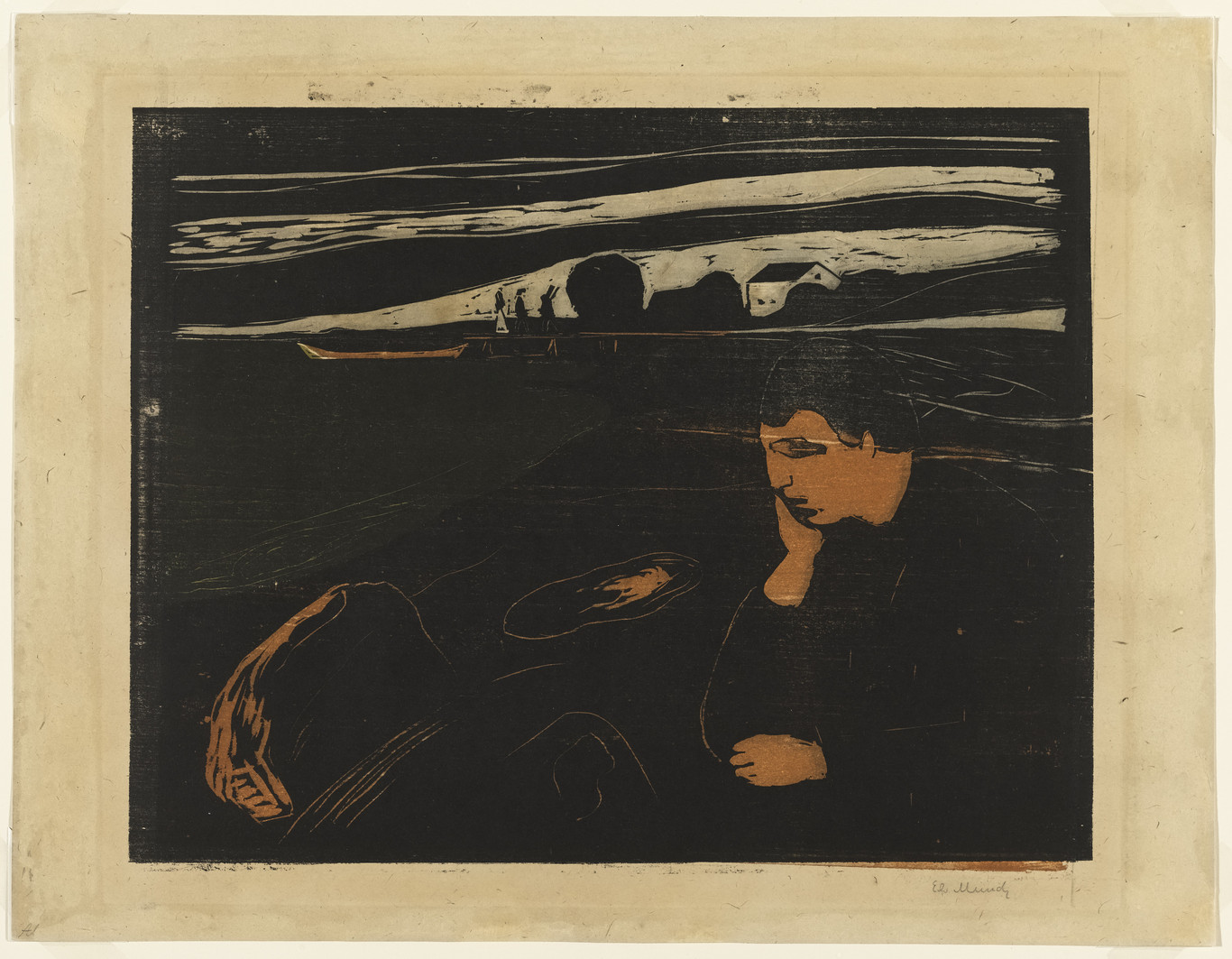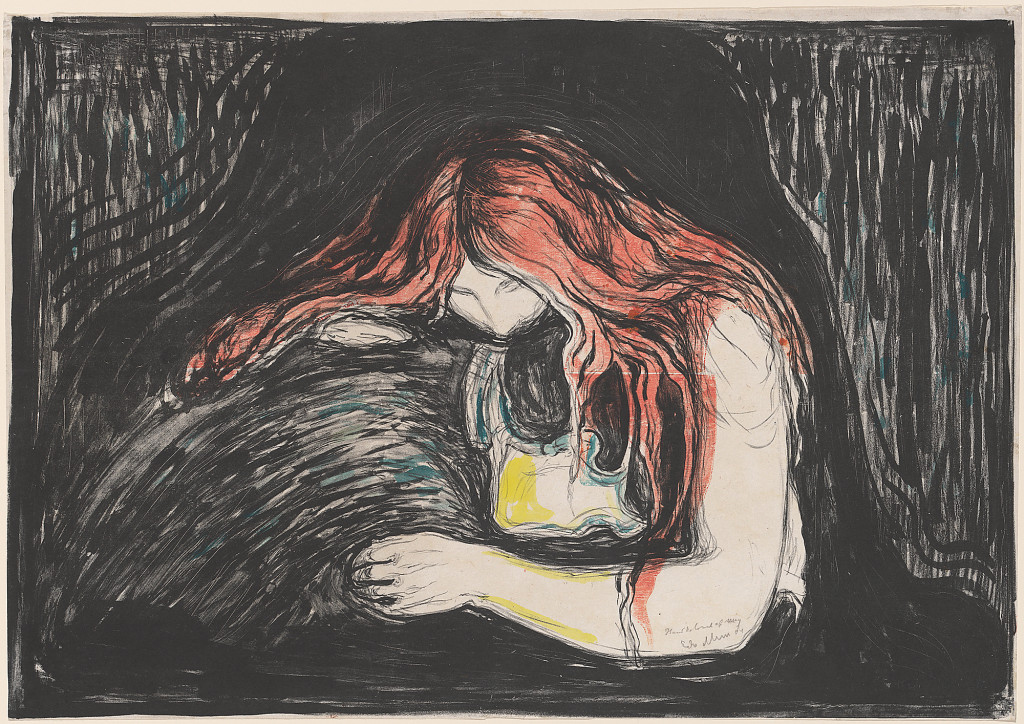National Gallery of Art
September 3, 2017, through January 28, 2018
In the second half of the 19th century, advances in physics, electromagnetic radiation theory, and the optical sciences provoked new thought about the physical as well as the spiritual worlds. Aspects of that thought are revealed in Edvard Munch: Color in Context, an exhibition of 21 prints that considers the choice, combinations, and meaning of color in light of spiritualist principles. Informed by popular manuals that explained the science of color and by theosophical writings on the visual and physical power of color, Edvard Munch (1863–1944) created works that are not just strikingly personal but also are charged with specific associations. Edvard Munch will be on view in the West Building from September 3, 2017, through January 28, 2018.
The majority of the prints in the exhibition come from the Epstein Family Collection, the largest and finest gathering of the artist's graphic work outside of his native Norway. Their holdings are being steadily donated to the Gallery.
"We are indebted to the Epstein family for their extraordinary commitment to the Gallery and to the understanding of Edvard Munch's art," said Earl A. Powell III, director, National Gallery of Art. "It is an honor to dedicate this exhibition to the memory of Lionel Epstein, who passed away earlier this year."
The Gallery has presented seven exhibitions on Munch: Woodcuts, Lithographs, and Etchings from Paul Gauguin and Edvard Munch (1947); Prints by Edvard Munch from the Rosenwald Collection (1972); "The Sick Girl" by Edvard Munch (1975); Edvard Munch: Symbols and Images (1978); Edvard Munch: Master Prints from the Epstein Family Collection (1990); Edvard Munch: Master Prints (2010); and Edvard Munch: A 150th Anniversary Tribute (2013).
The exhibition is organized by the National Gallery of Art, Washington.
Early in his life, Munch was exposed to spiritualism and aural concepts that became popular on an international scale at the end of the 19th century. His childhood vicar was the well-known spiritualist Reverend E. F. B. Horn. Additionally, as a young artist in Oslo, Norway, Munch would meet his friends directly across the street from traveling medium A. Stojohann's "Scientific Public Library." Given such exposure, Munch would have been open to the notion of spiritual power, four-dimensional planes, and invisible forces. It is known that he believed he could see energies radiating from specific colors.
Many of Munch's contemporaries, including Paul Gauguin (1848–1903), Maurice Denis (1870–1943), and Odilon Redon (1840–1916), were well aware of these new philosophies, and their work bears some general relation to them. In Munch's use of color, which intensified psychological and expressive meaning, the correlation with theosophical theories and ideas is specific.
The exhibition is curated by Jonathan Bober, Andrew W. Mellon Senior Curator of Prints and Drawings, and Mollie Berger, curatorial assistant in the department of prints and drawings, National Gallery of Art.
Edvard Munch
September 3, 2017, through January 28, 2018
In the second half of the 19th century, advances in physics, electromagnetic radiation theory, and the optical sciences provoked new thought about the physical as well as the spiritual worlds. Aspects of that thought are revealed in Edvard Munch: Color in Context, an exhibition of 21 prints that considers the choice, combinations, and meaning of color in light of spiritualist principles. Informed by popular manuals that explained the science of color and by theosophical writings on the visual and physical power of color, Edvard Munch (1863–1944) created works that are not just strikingly personal but also are charged with specific associations. Edvard Munch will be on view in the West Building from September 3, 2017, through January 28, 2018.
The majority of the prints in the exhibition come from the Epstein Family Collection, the largest and finest gathering of the artist's graphic work outside of his native Norway. Their holdings are being steadily donated to the Gallery.
"We are indebted to the Epstein family for their extraordinary commitment to the Gallery and to the understanding of Edvard Munch's art," said Earl A. Powell III, director, National Gallery of Art. "It is an honor to dedicate this exhibition to the memory of Lionel Epstein, who passed away earlier this year."
The Gallery has presented seven exhibitions on Munch: Woodcuts, Lithographs, and Etchings from Paul Gauguin and Edvard Munch (1947); Prints by Edvard Munch from the Rosenwald Collection (1972); "The Sick Girl" by Edvard Munch (1975); Edvard Munch: Symbols and Images (1978); Edvard Munch: Master Prints from the Epstein Family Collection (1990); Edvard Munch: Master Prints (2010); and Edvard Munch: A 150th Anniversary Tribute (2013).
The exhibition is organized by the National Gallery of Art, Washington.
Early in his life, Munch was exposed to spiritualism and aural concepts that became popular on an international scale at the end of the 19th century. His childhood vicar was the well-known spiritualist Reverend E. F. B. Horn. Additionally, as a young artist in Oslo, Norway, Munch would meet his friends directly across the street from traveling medium A. Stojohann's "Scientific Public Library." Given such exposure, Munch would have been open to the notion of spiritual power, four-dimensional planes, and invisible forces. It is known that he believed he could see energies radiating from specific colors.
Many of Munch's contemporaries, including Paul Gauguin (1848–1903), Maurice Denis (1870–1943), and Odilon Redon (1840–1916), were well aware of these new philosophies, and their work bears some general relation to them. In Munch's use of color, which intensified psychological and expressive meaning, the correlation with theosophical theories and ideas is specific.
The exhibition is curated by Jonathan Bober, Andrew W. Mellon Senior Curator of Prints and Drawings, and Mollie Berger, curatorial assistant in the department of prints and drawings, National Gallery of Art.
Edvard Munch
Self-Portrait, 1895
lithograph
sheet: 45.6 x 31.5 cm (17 15/16 x 12 3/8 in.)
National Gallery of Art, Washington, Rosenwald Collection
Edvard Munch
Melancholy III (Evening; On the Beach), 1901
color woodcut
framed: 70.17 x 80.33 x 4.45 cm (27 5/8 x 31 5/8 x 1 3/4 in.)
Epstein Family Collection
Edvard Munch
Melancholy (Woman on the Shore), 1898
color woodcut
framed: 60.01 x 65.09 x 3.18 cm (23 5/8 x 25 5/8 x 1 1/4 in.)
Epstein Family Collection
Edvard Munch
The Sin, 1902
color lithograph from two stones in beige, ochre and green
overall: 69.53 x 40.01 cm (27 3/8 x 15 3/4 in.)
framed: 102.55 x 69.22 x 3.97 cm (40 3/8 x 27 1/4 x 1 9/16 in.)
Epstein Family Collection
Edvard Munch
The Vampire (Vampyr), 1895
color lithograph and woodcut with watercolor [trial proof]
sheet: 38.9 x 55.7 cm (15 5/16 x 21 15/16 in.)
National Gallery of Art, Washington, Ailsa Mellon Bruce Fund and Gift of Lionel C. Epstein
Edvard Munch
Anxiety, 1896
color lithograph printed in black and red
overall: 41.28 x 38.74 cm (16 1/4 x 15 1/4 in.)
Epstein Family Collection
Edvard Munch
Moonlight I, 1896
color woodcut
overall: 41.2 x 47.5 cm (16 1/4 x 18 11/16 in.)
framed: 70.96 x 76.99 x 3.81 cm (27 15/16 x 30 5/16 x 1 1/2 in.)
Epstein Family Collection
Edvard Munch
Girl's Head Against the Shore, 1899
color woodcut
framed: 78.11 x 67.63 x 3.49 cm (30 3/4 x 26 5/8 x 1 3/8 in.)
Epstein Family Collection
Edvard Munch
Man's Head in Woman's Hair (Mannerkopf in Frauenharr), 1896
color woodcut
sheet: 55.9 x 38.8 cm (22 x 15 1/4 in.)
National Gallery of Art, Washington, Rosenwald Collection
Edvard Munch
The Kiss in the Field, 1943
woodcut printed in red-brown with watercolor on wove paper
block: 40.4 x 49 cm (15 7/8 x 19 5/16 in.)
overall: 53.8 x 64.1 cm (21 3/16 x 25 1/4 in.)
National Gallery of Art, Washington, Gift of Ruth Cole Kainen
Edvard Munch
Madonna, 1895, printed 1913/1914
color lithograph
overall: 60.01 x 44.13 cm (23 5/8 x 17 3/8 in.)
National Gallery of Art, Washington, Gift of The Epstein Family Collection
Edvard Munch
Old Man Praying, 1902
color woodcut
framed: 84.46 x 64.14 x 3.81 cm (33 1/4 x 25 1/4 x 1 1/2 in.)
Epstein Family Collection
Edvard Munch
Encounter in Space, 1902
etching and aquatint
framed: 64.61 x 55.56 x 2.7 cm (25 7/16 x 21 7/8 x 1 1/16 in.)
Epstein Family Collection
Edvard Munch
Head by Head, 1905
color woodcut
framed: 68.58 x 84.14 x 3.18 cm (27 x 33 1/8 x 1 1/4 in.)
Epstein Family Collection













Comments
Post a Comment